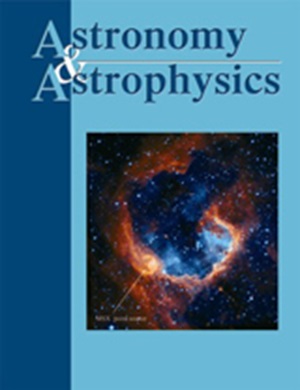CARMENES 搜寻 M 矮星周围的系外行星
IF 6.5
2区 物理与天体物理
引用次数: 1
摘要
目的我们报告了两颗M0.0 V恒星GJ 338 B和GJ 338 A的径向速度时间序列,使用的是CARMENES光谱仪,并辅以Las Cumbres和Sierra Nevada天文台的地面望远镜光度测量。我们的目的是利用光谱径向速度技术探索小行星在紧密轨道上的存在。2016年1月至2018年10月期间,我们利用CARMENES可见光通道分别获得了159和70次GJ 338 B和A的径向速度测量数据。我们还汇编了文献中的其他相对径向速度测量数据和涵盖200 a观测的天体测量数据集,以求解双星轨道。我们发现GJ 338 B的动力质量为0.64±0.07 M⊙,GJ 338 A的动力质量为0.69±0.07 M⊙。CARMENES径向速度周期图在16.61±0.04 d(GJ 338 B)和16.3-1.3+3.5 d(GJ 338 A)处显示出明显的峰值,这在CARMENES活动指标和光度测量光曲线中具有相同频率的对应峰值。我们将其归因于恒星自转。GJ 338 B 在 8.27 ± 0.01 和 24.45 ± 0.02 d 显示了两个额外的重要信号,在恒星活动指数中没有明显的对应信号。前一个信号可能是恒星自转的第一次谐波,而后一个信号则可能是一颗质量最小为 10.27-1.38+1.47 M⊕ 的超地球行星在围绕 GJ 338 B 运转。GJ 338 Bb位于母恒星周围宜居带的内边界。它是迄今为止在恒星双星成员周围发现的质量最小的行星之一。两颗恒星的质量、光谱类型、亮度,甚至旋转周期都非常相似,它们很可能是共生的,由相同的分子云形成,但它们的行星系统结构却不同。本文章由计算机程序翻译,如有差异,请以英文原文为准。
The CARMENES search for exoplanets around M dwarfs
Aims. We report on radial velocity time series for two M0.0 V stars, GJ 338 B and GJ 338 A, using the CARMENES spectrograph, complemented by ground-telescope photometry from Las Cumbres and Sierra Nevada observatories. We aim to explore the presence of small planets in tight orbits using the spectroscopic radial velocity technique.
Methods. We obtained 159 and 70 radial velocity measurements of GJ 338 B and A, respectively, with the CARMENES visible channel between 2016 January and 2018 October. We also compiled additional relative radial velocity measurements from the literature and a collection of astrometric data that cover 200 a of observations to solve for the binary orbit.
Results. We found dynamical masses of 0.64 ± 0.07 M⊙ for GJ 338 B and 0.69 ± 0.07 M⊙ for GJ 338 A. The CARMENES radial velocity periodograms show significant peaks at 16.61 ± 0.04 d (GJ 338 B) and 16.3−1.3+3.5 d (GJ 338 A), which have counterparts at the same frequencies in CARMENES activity indicators and photometric light curves. We attribute these to stellar rotation. GJ 338 B shows two additional, significant signals at 8.27 ± 0.01 and 24.45 ± 0.02 d, with no obvious counterparts in the stellar activity indices. The former is likely the first harmonic of the star’s rotation, while we ascribe the latter to the existence of a super-Earth planet with a minimum mass of 10.27−1.38+1.47 M⊕ orbiting GJ 338 B. We have not detected signals of likely planetary origin around GJ 338 A.
Conclusions. GJ 338 Bb lies inside the inner boundary of the habitable zone around its parent star. It is one of the least massive planets ever found around any member of stellar binaries. The masses, spectral types, brightnesses, and even the rotational periods are very similar for both stars, which are likely coeval and formed from the same molecular cloud, yet they differ in the architecture of their planetary systems.
求助全文
通过发布文献求助,成功后即可免费获取论文全文。
去求助
来源期刊

Astronomy & Astrophysics
ASTRONOMY & ASTROPHYSICS-
自引率
27.70%
发文量
0
期刊介绍:
Astronomy & Astrophysics is an international Journal that publishes papers on all aspects of astronomy and astrophysics (theoretical, observational, and instrumental) independently of the techniques used to obtain the results.
 求助内容:
求助内容: 应助结果提醒方式:
应助结果提醒方式:


